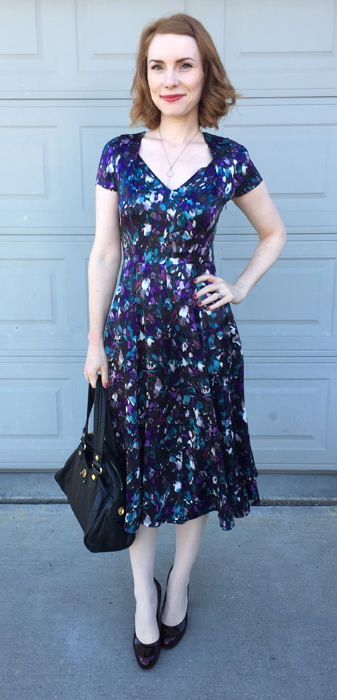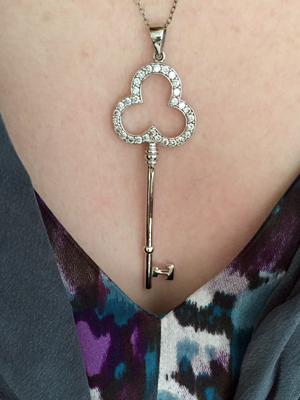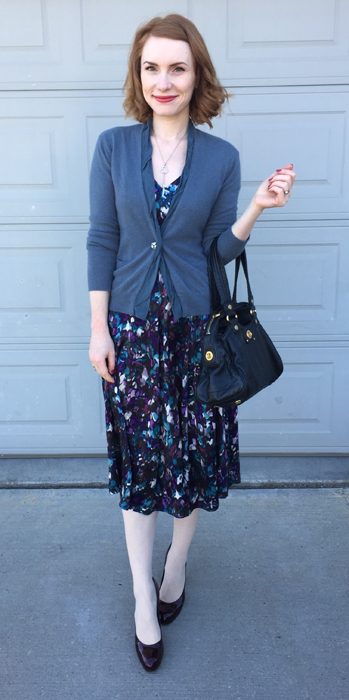
This dress is a little tricky. It feels rather fancy for everyday wear, but not quite full-on glam. In the end, I wore it to the office — mostly because it was too pretty to “save” for a special occasion. It proved to be a mistake, though not for aesthetic reasons. Turns out, these cap sleeves are very unforgiving; they are very fitted, which is fine if I keep my hands by my side, but as soon as I start moving … no bueno. It’s a problem, because approximately 90% of my day involves typing. So this dress will be a “special occasion” piece after all.
Here are some of the other things I wore.


The necklace is old (one of those amazeballs Winners finds of fantastic quality) and the cardigan is the one I love and some of you hate. I promise I’m not wearing it all the time just to annoy you. It just goes with everything, you know?


I love the cardigan. 🙂 I thought maybe you could put (or have a seamstress put) a v-shaped notch in the sleeves’s hem to give you a bit more space for movement? Nothing worse than not being able to move your arms while you look good.
Yes!! I’ve been thinking of doing that. I just have to get around to it now. Great minds think alike 😉
Adina, did you see this article? I think it will resonate with you!
http://qz.com/686346/before-you-buy-another-piece-of-clothing-heres-a-new-way-of-looking-at-its-pricetag/
Also would love if you did a post on how you store your items… Are you a Marie Kondo convert?
Just curious because I love hearing your take on these things!
It’s an interesting read, thanks for linking to it. I agree with the sentiment behind it, but I think there are a few other factors that play into it. For example, buying more expensive things might incent the person to buy fewer things — but it doesn’t necessarily always work. It’s how some people get into financial trouble, after all. Also, more expensive things don’t necessarily last longer than inexpensive ones. Quality is wildly unpredictable these days — across brands, and within the same brands. Another thing is that a lot of people — whether innately or because we’ve been “trained” by the fashion/retail industry — enjoy having variety. I’ve been reading Reddit discussions on this topic and this seems to be the reason a lot of people end up buying fast fashion — to have variety, to try out different styles, etc. It’s a vicious circle; fast fashion enables sartorial exploration, which in turns feeds the demand for more fast fashion. I don’t know that the ideas offered in that article really address that. Also, people don’t necessarily want to contribute to environmental pollution (or slave labour), but that’s an abstract concept for the most part — it’s difficult to use it to change people’s day to day behaviour. After all, we still drive cars, use non-renewable sources of energy, etc. I’m not saying it’s impossible, but it requires a heck of a lot of willpower, in addition to awareness.
For me, secondhand shopping is the easy way to assuage my own guilt. I’m helping minimize the impacts of over-consumption, while over-consuming. It’s cheating, in a way, but it’s better than the alternative for me. Plus, financially it makes way more sense. I only have to wear a thrifted garment 5-10 times, and my CPW is $1. That’s doable in most cases, even for me (and there is a LOT of turnover in my closet).
There are other things I think can be more easily done to minimize impacts of our consumption — like the washing thing. I don’t wash my clothes every time I wear them (unmentionables excluded). I only wash things if I’ve been sweating a lot (tops), or if they get actually dirty (stains, scuffs, etc.). I hand wash and air dry a fair chunk of my (delicate) clothes too — which is not that onerous given that I don’t have to do it constantly.
I also think services like Rent the Runway can be a fantastic long-term solution, especially if we extend it to all types of clothing, not just high end designer stuff.
As for Marie Kondo … I am not a convert. I am a collector at heart, which I think is diametrically opposed to what Kondo is all about. I am drawn to the idea of a capsule of different uniforms or “looks” if you will, where the individual pieces are constantly changing … versus a capsule of finite items. The idea of trying to find THE perfect something stresses me out. Oh, and my closet is really nothing to write home about; I just use those velvet hangers that maximize space. I don’t fold my clothes in any particular way either.
Sorry for the novel, but I really do love a good discussion on this topic!
Love the novel! You should write one (teehee)
Its funny how they don’t address secondhand shopping as an alternative way to keep CPW low. You’ve shown time and time again that there is great variety to be had that doesn’t require buying into fast fashion from retail every season.
One more thing, thoughts on the 70/30 rule in the article? I personally think it’s a good rule of thumb for my budget at the very least, but I am not sure my closet really reflects it at the moment.
The dress really is very lovely. Too bad about the sleeves, though!
Thanks, Xin! I’m going to look into having them altered.